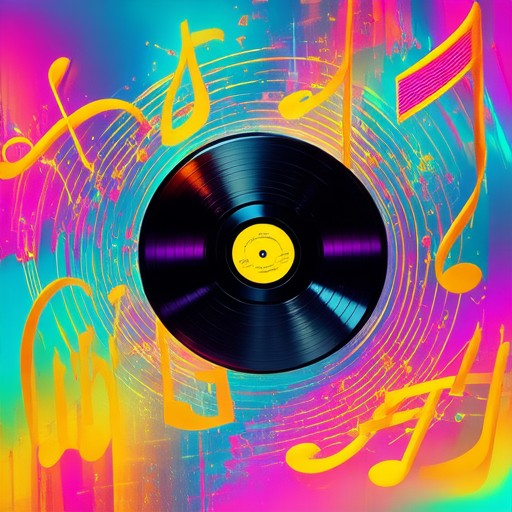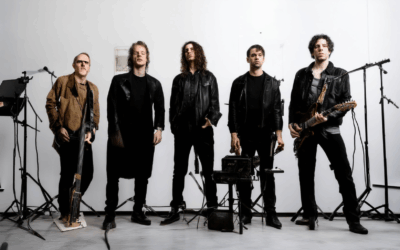Rock music albums have long been more than just collections of tracks—they are visual and auditory experiences that tell stories, convey emotions, and often serve as lasting mementos for fans. From the iconic cover art that grabs attention to the meticulously crafted track listings that guide listeners through a journey, every aspect of rock music album design plays a pivotal role in shaping the overall experience. Whether it’s the consistency of branding that reinforces a band’s identity or the thoughtful inclusion of photography that adds depth, each element contributes to creating a cohesive and memorable piece of art. As we delve into the essential components, explore the standout features, and uncover the evolution of rock album design, one thing becomes clear: the interplay between creativity and functionality is what truly defines a great rock music album design.
Key Takeaways
- A Striking Cover Art Captures Attention and Communicates the Album’s Essence, Often Becoming Synonymous with the Band
- A Cohesive Theme Creates a Unified Visual Narrative, Enhancing the Listener’s Experience and Immersing Them in the Album’s World
- Innovative Typography Conveys Strength and Energy, Reinforcing the Band’s Identity and Adding a Raw, Unconventional Flair
- A Strong Color Palette Evokes Mood and Aligns with the Band’s Image, Whether Darker Palettes for Intensity or Brighter Colors for Energy
- Visual Hierarchy Balances Detail and Simplicity, Ensuring Key Elements Like Band Name and Title Are Immediately Noticeable
- The Album Layout Continues the Cover’s Theme Internally, With Creative Track Listings and Special Features Like Gatefolds
- Art Direction and Storytelling Elevate the Design, Telling a Story or Evoke Emotion That Resonates Deeply with Listeners
- Collaboration with Renowned Designers Ensures a Cohesive, Impactful Design That Reflects the Band’s Vision and Identity

The Key Components of Rock Music Album Design
The design of a rock music album is a critical aspect that separates a good release from a great one. Here are the essential elements that go into crafting a standout rock album design:
- Cover Artwork :
The album cover is often the first impression potential listeners have of the music. A compelling cover art can convey the band’s identity, evoke emotions, and communicate the essence of the album. It should be visually striking and aligned with the band’s style, whether it’s a bold graphic, a thought-provoking photograph, or a minimalist design. - Typography :
The font choices, sizing, and layout of the album’s title, song titles, and credits play a significant role in the overall aesthetic. Clean, readable typography ensures the artwork doesn’t overshadow the content, while bold, eye-catching fonts can emphasize the band’s personality. - Tracklist Arrangement :
The order of songs on the album can greatly influence how fans engage with the music. A well-curated tracklist might highlight the band’s progression, showcase their versatility, or tell a story through the sequence of tracks. - Visual Elements :
Beyond the cover, visuals like band photos, tour dates, and lyrics printed on the booklet or CD insert add depth to the physical artifact. These elements contribute to the fan experience and can tie the artwork together. - Overall Aesthetic Cohesion :
Every element of the album, from the cover to the booklet, should feel cohesive. Consistency in color palette, font choice, and design style reinforces the band’s brand and creates a memorable experience for listeners. - Booklet and Liner Notes :
While optional, a well-designed booklet or liner notes can enhance the physicality of the album. It provides additional content like lyrics, behind-the-scenes photos, or essays that add value to the purchase.
By thoughtfully combining these elements, a rock music album design can become a work of art that resonates with fans and stands the test of time.
Essential Elements of a Great Rock Music Album Design
A great rock music album design isn’t just about the music—it’s about creating a visual and emotional experience that resonates with listeners. Here are the key components that define a standout rock album design:
- Visual Identity: A bold and consistent visual style is crucial. Rock album designs often feature vibrant colors, gritty textures, and bold typography that reflect the energy of the music. Use high-contrast colors and impactful imagery to grab attention.
- Cohesive Theme: Every element of the design should tie together to tell a story or convey a mood. Whether it’s the cover art, lyrics, or even the typography, ensure there’s a unifying theme that connects with the listener emotionally.
- Typography Matters: The font choice and layout play a significant role in the overall feel of the album. Clean, modern fonts work well for alternative rock, while rough, hand-drawn fonts might suit grunge or hard rock styles. Consistency is key.
- Packaging Excellence: From the CD case to vinyl sleeves, the physical packaging should complement the digital experience. High-quality materials and thoughtful details enhance the tactile experience of the album.
- Conceptual Depth: A well-thought-out concept can elevate an album design. This could involve a narrative arc, symbolic imagery, or a retro aesthetic that pays homage to classic rock vibes.
These elements work together to create a design that not only complements the music but also enhances the overall fan experience. Whether you’re a die-hard rock enthusiast or a newcomer to the scene, a thoughtfully crafted album design can leave a lasting impression.

What Defines a Standout Rock Music Album Design?
A standout rock music album design is characterized by its ability to capture the essence of the band, resonate with fans, and leave a lasting impression. Here’s what sets great rock album designs apart:
- Bold and Iconic Cover Art :
The cover art often serves as the first impression. A great rock album cover might feature bold imagery, rebellious symbols, or thought-provoking visuals that reflect the band’s identity. For instance, the iconic “Never Mind the Bollocks” cover remains memorable due to its raw energy and simplicity. - Unique Typography and Fonts :
Rock album designs frequently experiment with typography to convey a strong visual message. Bold, unconventional fonts paired with vibrant colors can make an album cover stand out. The use of distressed textures or retro styles adds a nostalgic touch that appeals to rock enthusiasts. - Color Scheme and Contrast :
Vibrant color palettes and high-contrast designs are common in rock album art. These elements create eye-catching visuals that complement the music’s intensity. A well-chosen color scheme can evoke emotions and reinforce the band’s brand identity. - Storytelling Through Imagery :
Many rock album designs tell a story or convey a theme. From classic rock covers that depict eras past to modern designs that reflect current cultural trends, the imagery should resonate with the listener on a deeper level. - Rebellious and edgy elements :
Rock music is inherently about rebellion, and this sentiment is often reflected in album designs. Symbols like chains, fire, or devil horns can symbolize freedom, chaos, or defiance, making the cover feel provocative and authentic. - Consistency Across Branding :
A great rock album design aligns seamlessly with the band’s overall branding. This consistency ensures that fans recognize the band immediately, whether they’re looking at a CD, vinyl, or digital artwork. - Innovative Layout and Structure :
Rock album designs often push creative boundaries. Unique layouts, gatefolds, or interactive elements can elevate the experience. These innovations keep the design fresh and engaging, even for long-time fans. - Fan Engagement and Connection :
The best rock album designs connect with fans on a personal level. They might feature hidden messages, exclusive photos, or artwork that reflects shared experiences between the band and their audience. - Historical Context :
Some rock album designs become iconic because they reflect the cultural or historical significance of the era. These designs often stand the test of time, becoming synonymous with the band’s legacy. - Collaboration Between Artists :
Great album designs often result from collaboration between the band, artists, and designers. This teamwork ensures that the final product feels cohesive and purposeful, enhancing the overall impact of the artwork.
By combining these elements, a rock music album design can transcend its role as mere packaging and become an integral part of the band’s identity and legacy.

Essential Elements of Rock Music Album Design
The design of a rock music album is a critical aspect that sets it apart from the rest. A great album design goes beyond just visuals—it tells a story, evokes emotion, and creates a lasting impression. Here are the key elements that make rock music album designs stand out:
- Cover Art
- Cohesive Theme
- Innovative Typography
- Strong Color Palette
- Visual Hierarchy
- Album Layout
- Art Direction and Storytelling
- Collaboration with Designers
1. Cover Art
The album cover is often the first point of contact with the audience. A striking cover art can capture attention and communicate the essence of the album. Many iconic rock albums, like those by Foo Fighters and Radiohead, feature bold and thought-provoking covers that become synonymous with the band.
2. Cohesive Theme
A theme that runs throughout the album design ties everything together. This theme could be visual, conceptual, or emotional. For example, Linkin Park’s “Metallia” concept extends from their album cover to the internal artwork, creating a immersive experience for the listener.
3. Innovative Typography
Typography plays a crucial role in rock album design. Clean, bold fonts are common in rock music to convey strength and energy. Bands like Pearl Jam use consistent typography across their discography, reinforcing their brand identity.
4. Strong Color Palette
Color choice is vital in rock album design. Darker palettes often convey intensity and mood, while brighter colors can signify energy and excitement. The color scheme should complement the overall aesthetic and align with the band’s image.
5. Visual Hierarchy
Effective album design balances detail with simplicity. The most important elements—such as the band name, album title, and central imagery—should be immediately noticeable. This ensures the cover grabs attention while still telling a story.
6. Album Layout
Inside the album, the layout should continue the theme established on the cover. Track listings can be minimalist or creative, depending on the band’s vision. Some albums feature gatefolds or special inserts that enhance the physical experience.
7. Art Direction and Storytelling
Great album designs often tell a story or evoke a specific emotion. For instance, the artwork for Slayer’s “Reign of Blood” uses disturbing imagery to reflect the band’s violent themes. This level of art direction makes the album memorable.
8. Collaboration with Designers
Many rock bands collaborate with renowned designers to achieve a standout look. These partnerships ensure that the final product is both visually impactful and emotionally resonant. Artists like Iron Maiden have worked with multiple award-winning designers to create iconic album covers.
By combining these elements, rock music album designs create a unique identity that captivates listeners and stands the test of time. Whether through bold visuals, thoughtful storytelling, or innovative design choices, the best rock albums leave a lasting impression.
For more insights into rock music and album design, explore our Oedipus Band website. We offer exclusive content, music reviews, and behind-the-scenes looks at the creativity behind your favorite bands.
What Defines a Standout Rock Music Album Design?
A standout rock music album design is characterized by its ability to capture the essence of the band, resonate with fans, and leave a lasting impression. Here’s what sets great rock album designs apart:
- Bold and Iconic Cover Art :
The cover art often serves as the first impression. A great rock album cover might feature bold imagery, rebellious symbols, or thought-provoking visuals that reflect the band’s identity. For instance, the iconic “Never Mind the Bollocks” cover remains memorable due to its raw energy and simplicity. - Unique Typography and Fonts :
Rock album designs frequently experiment with typography to convey a strong visual message. Bold, unconventional fonts paired with vibrant colors can make an album cover stand out. The use of distressed textures or retro styles adds a nostalgic touch that appeals to rock enthusiasts. - Color Scheme and Contrast :
Vibrant color palettes and high-contrast designs are common in rock album art. These elements create eye-catching visuals that complement the music’s intensity. A well-chosen color scheme can evoke emotions and reinforce the band’s brand identity. - Storytelling Through Imagery :
Many rock album designs tell a story or convey a theme. From classic rock covers that depict eras past to modern designs that reflect current cultural trends, the imagery should resonate with the listener on a deeper level. - Rebellious and edgy elements :
Rock music is inherently about rebellion, and this sentiment is often reflected in album designs. Symbols like chains, fire, or devil horns can symbolize freedom, chaos, or defiance, making the cover feel provocative and authentic. - Consistency Across Branding :
A great rock album design aligns seamlessly with the band’s overall branding. This consistency ensures that fans recognize the band immediately, whether they’re looking at a CD, vinyl, or digital artwork. - Innovative Layout and Structure :
Rock album designs often push creative boundaries. Unique layouts, gatefolds, or interactive elements can elevate the experience. These innovations keep the design fresh and engaging, even for long-time fans. - Fan Engagement and Connection :
The best rock album designs connect with fans on a personal level. They might feature hidden messages, exclusive photos, or artwork that reflects shared experiences between the band and their audience. - Historical Context :
Some rock album designs become iconic because they reflect the cultural or historical significance of the era. These designs often stand the test of time, becoming synonymous with the band’s legacy. - Collaboration Between Artists :
Great album designs often result from collaboration between the band, artists, and designers. This teamwork ensures that the final product feels cohesive and purposeful, enhancing the overall impact of the artwork.
By combining these elements, a rock music album design can transcend its role as mere packaging and become an integral part of the band’s identity and legacy.

What Defines a Standout Rock Music Album Design?
A standout rock music album design is characterized by its bold visual identity, innovative use of typography, and ability to convey the essence of the band’s personality. Here’s a breakdown of the key elements:
-
Unique Cover Art
- The album cover serves as the first impression. A striking image or design that reflects the band’s style or themes is crucial. Iconic rock album covers often feature bold colors, rebellious imagery, or abstract concepts that resonate with listeners.
-
Innovative Typography
- The font choice and layout of the album title and track names play a significant role. Clean, modern fonts paired with gritty, distressed textures can give the album a raw, energetic feel. Handwritten fonts or unconventional layouts can add a unique touch.
-
Consistent Branding
- The design should align with the band’s existing branding, including their logo and color scheme. Consistency helps in building a recognizable identity. For example, Black Sabbath’s “Paranoid” album uses a dark, ominous color palette that matches their heavy metal theme.
-
Rebellious Imagery
- Rock albums often feature imagery that symbolize rebellion, freedom, or defiance. This could be through gritty photos, distorted graphics, or symbolic motifs like chains, fire, or devilish imagery.
-
Track Listing Layout
- The track listing should be intuitive and visually appealing. A clean, minimalist layout with clear typography ensures fans can easily navigate the tracks. Some albums experiment with gatefolds or interactive elements to enhance the listening experience.
-
Liner Notes and Booklets
- High-quality liner notes and booklets add depth to the physical artwork. These sections often include lyrics, band photos, and storytelling elements that complement the music.
-
Overall Theme Consistency
- Every design element should tie back to the album’s central theme or concept. This thematic consistency creates a cohesive visual narrative that resonates with the audience.
Competitor Insights
– Bands like Led Zeppelin, Pink Floyd, and The Rolling Stones have set high standards for rock album design. Their works often serve as benchmarks for creativity and innovation in the genre.
Conclusion
A truly standout rock music album design goes beyond aesthetics—it tells a story, evokes emotions, and becomes a part of the band’s legacy. By focusing on these key elements, artists can create something that not only stands out but also connects deeply with their audience.



0 Comments